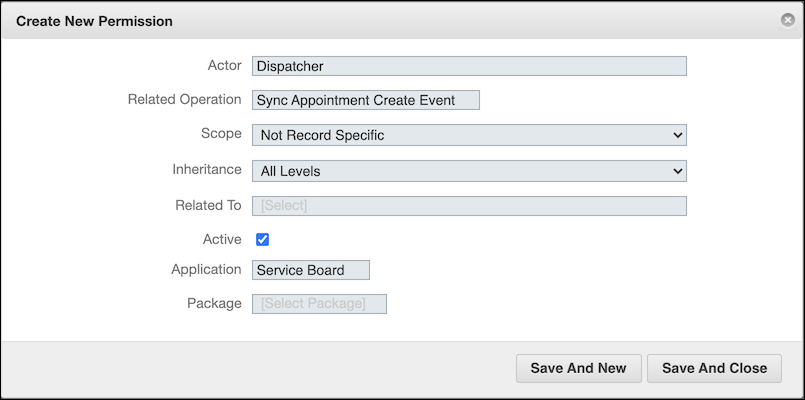Creating Custom Transform Operations
By default, Salesforce-to-Service Board real-time data sync is handled by predefined transform action functions that are configured for use by the associated transform templates. In cases where you want to override this default behavior, you can configure custom transform operations.
|
|
The Transform Operation field in the Transform Template object is overwritten whenever release versions are upgraded. Because any updates to this field value are not preserved at upgrade, you must create a custom transform template to execute the custom transform operation.
|
The following steps show an example of how to configure a custom transform operation for the SFE to Appointment Create transform template.
To create custom transform operations:
1. In Max Designer, on the Developer Tools ( ) launchpad menu, click Sources, and then in the list view, in the top left corner, click Create(
) launchpad menu, click Sources, and then in the list view, in the top left corner, click Create( ) and complete the fields as follows to create a new Source record.
) and complete the fields as follows to create a new Source record.
◦ Name: com.servicemax.dc.operation.integration.SyncAppointmentCreateOperation
◦ Application: Service Board
◦ Code:
/*
* Copyright (C) 2007-present, ServiceMax Inc.
*
* The program(s) herein may be used and/or copied only with
* the written permission of ServiceMax Inc. or in accordance with
* the terms and conditions stipulated in the agreement/contract
* under which the program(s) have been supplied.
*/
package com.servicemax.dc.operation.integration
import com.servicemax.core.Database
import com.servicemax.core.Max
import com.servicemax.core.annotations.Application
import com.servicemax.transform.operation.TransformOperation
@Application(application = 'svmx_dispatch_console')
class SyncAppointmentCreateOperation extends TransformOperation {
@Override
protected Object realExecute(Map<String, Object> parameters) throws Exception {
SyncOperationHelper.validateParameters(parameters)
def result = [success: true]
Collection<Object> convertedRecords = parameters.get('records')
Map record = (Map) convertedRecords.iterator().next()
String externalId = record.get('io_external_id')
if (!isExistedInSB(externalId)) {
executePatch('svmx_appointment', convertedRecords, null)
}
return result
}
private boolean isExistedInSB(String externalId) {
Max.executeInTransaction {
Integer size = Database.queryObject('SELECT count(*) FROM svmx_appointment WHERE io_external_id = :io_external_id', [io_external_id: externalId])
return size > 0
}
}
}
* Copyright (C) 2007-present, ServiceMax Inc.
*
* The program(s) herein may be used and/or copied only with
* the written permission of ServiceMax Inc. or in accordance with
* the terms and conditions stipulated in the agreement/contract
* under which the program(s) have been supplied.
*/
package com.servicemax.dc.operation.integration
import com.servicemax.core.Database
import com.servicemax.core.Max
import com.servicemax.core.annotations.Application
import com.servicemax.transform.operation.TransformOperation
@Application(application = 'svmx_dispatch_console')
class SyncAppointmentCreateOperation extends TransformOperation {
@Override
protected Object realExecute(Map<String, Object> parameters) throws Exception {
SyncOperationHelper.validateParameters(parameters)
def result = [success: true]
Collection<Object> convertedRecords = parameters.get('records')
Map record = (Map) convertedRecords.iterator().next()
String externalId = record.get('io_external_id')
if (!isExistedInSB(externalId)) {
executePatch('svmx_appointment', convertedRecords, null)
}
return result
}
private boolean isExistedInSB(String externalId) {
Max.executeInTransaction {
Integer size = Database.queryObject('SELECT count(*) FROM svmx_appointment WHERE io_external_id = :io_external_id', [io_external_id: externalId])
return size > 0
}
}
}

2. In Max Designer, on the Developer Tools ( ) launchpad menu, click Operations, and then in the list view, in the top left corner, click Create (
) launchpad menu, click Operations, and then in the list view, in the top left corner, click Create ( ) and complete the fields as follows to create a new Operation record.
) and complete the fields as follows to create a new Operation record.
Field | Value |
|---|---|
Name | Sync Appointment Create Event |
Identifier | sync_appointment_create_event |
Computer Language | Groovy |
Class Name | com.servicemax.dc.operation.integration.SyncAppointmentCreateOperation |
Method Name | execute |
3. In the newly created record, on the Relations tab, in the Related Lists view, in the top right corner, click Show All Relationships ( ), and then click to open the Permissions list that has a Relationship column value of Permission Related Operation.
), and then click to open the Permissions list that has a Relationship column value of Permission Related Operation.

4. In the Permission Related Operations list view, click Create ( ), and then in the Create New Permission dialog box, complete the fields as follows to create three Permission records for the Dispatcher, Service Board Integration, and Service Board Administrator roles.
), and then in the Create New Permission dialog box, complete the fields as follows to create three Permission records for the Dispatcher, Service Board Integration, and Service Board Administrator roles.
◦ Actor: Dispatcher, Service Board Integration, and Service Board Administrator
◦ Scope: Not Record Specific
◦ All Other Fields: Accept default values

5. In Max Designer, on the Developer Tools ( ) launchpad menu, click Transform Templates, and then in the list view, click a transform template, for example, SFE to Appointment Create Template.
) launchpad menu, click Transform Templates, and then in the list view, click a transform template, for example, SFE to Appointment Create Template.
6. On the record page, in the top right corner, on the Options ( ) menu, click Copy, and then in the newly copied record, complete the fields as follows.
) menu, click Copy, and then in the newly copied record, complete the fields as follows.
Field | Value |
|---|---|
Name | SFE to Appointment Create Custom Template |
Identifier | salesforce_event_svmx_appointment_create_custom |
Transform Operation | Sync Appointment Create Event |
7. In Max Designer, on the Administration ( ) launchpad menu, click Settings, and then in the list view, in the top left corner, click Create (
) launchpad menu, click Settings, and then in the list view, in the top left corner, click Create ( ) and complete the fields as follows to define custom real-time sync rules for your newly created transform operation.
) and complete the fields as follows to define custom real-time sync rules for your newly created transform operation.
Field | Value |
|---|---|
Name | SFDC Real-Time Sync Custom Transform Rules |
Applicable Application | Service Board |
Identifier | sfdc_realtime_sync_custom_transform_rules |
Datatype | Code |
Default Value | { "create_SFE_Appointment": [ { "id": "salesforce_event_svmx_appointment_create_custom" } ]} |
Application | Service Board |
8. In Max Admin, on the Development Actions ( ) launchpad menu, click Synchronize.
) launchpad menu, click Synchronize.
For more information: